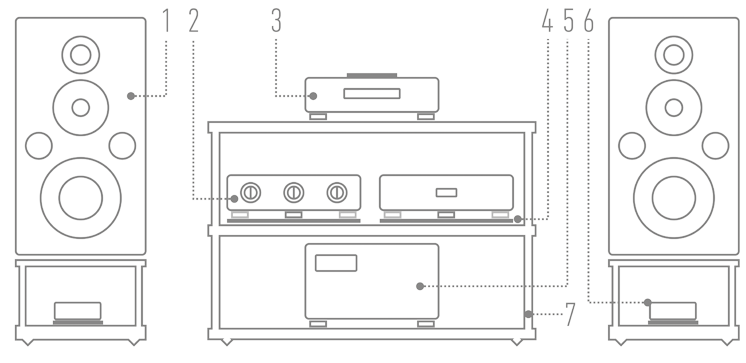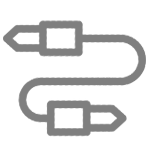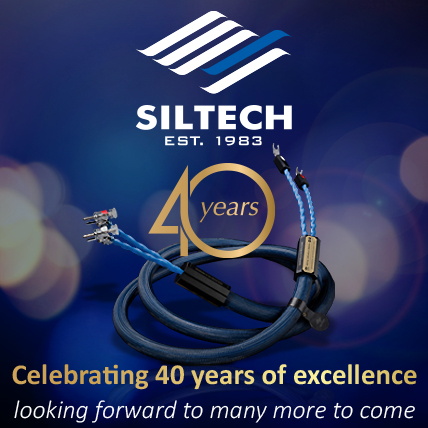PREMIERE
⌈ NEXT LEVEL TECH is one of the youngest Polish audio companies. It was founded at the beginning of this year by Mr. ROBERT SŁOWIŃSKI and specializes in audio cables. We are testing the WATER interconnect and it is a PREMIERE review. ⌋
 T HAPPENS EVERY NOW AND THEN, ALTHOUGH QUITE RARELY. This is how such companies as: PYLON AUDIO, PRO AUDIO BONO, FEZZ AUDIO, AUDIO REVEAL, DIVINE ACOUSTICS and others, well-known today, at some point started their adventure in the world of audio with a visit to "HIGH FIDELITY". It usually starts with an e-mail - this time it was sent by Mr. ROBERT SŁOWIŃSKI, who was going to start an audio company: T HAPPENS EVERY NOW AND THEN, ALTHOUGH QUITE RARELY. This is how such companies as: PYLON AUDIO, PRO AUDIO BONO, FEZZ AUDIO, AUDIO REVEAL, DIVINE ACOUSTICS and others, well-known today, at some point started their adventure in the world of audio with a visit to "HIGH FIDELITY". It usually starts with an e-mail - this time it was sent by Mr. ROBERT SŁOWIŃSKI, who was going to start an audio company:

 My name is Robert Słowiński. I have been reading "High Fidelity" and your reviews for a long time, living in a foreign country (the Netherlands). I also had a pleasure of meeting you at audio shows. I have been living in Poland for ten years and I started to produce audio cables commercially in a strange way. Next Level Tech (NxLT) has been operating since January. I was also persuaded to this business by my friends, other "Audio-Maniacs", who appreciated cables I made for them. I hope that my products is worthy of your attention and possibly of a review. My name is Robert Słowiński. I have been reading "High Fidelity" and your reviews for a long time, living in a foreign country (the Netherlands). I also had a pleasure of meeting you at audio shows. I have been living in Poland for ten years and I started to produce audio cables commercially in a strange way. Next Level Tech (NxLT) has been operating since January. I was also persuaded to this business by my friends, other "Audio-Maniacs", who appreciated cables I made for them. I hope that my products is worthy of your attention and possibly of a review.
I never refuse such requests, because usually there is a real passion, experience and determination behind them. Asking for your product to be review in a test in which it will be compared to the best cables in the world requires a lot of courage, so it is not based on impulse, but a deliberate decision. After a few more e-mails, we agreed to test one of the two currently available models, an analog RCA interconnect called WATER.
»«
| A few simple words…
ROBERT SŁOWIŃSKI
Owner, designer

⸜ ROBERT SŁOWIŃSKI in his workshop
I HAVE BEEN A MEMBER OF the DIY community for years. I spent two years searching for a good conductor for myself to apply it to my amps, DIY preamps and get top performance of them. I had my own favorite cable design, which was the Hijiri XLR Million. And I was even supposed to use it in my amplifiers, but my conscience did not allow me to "cut up" the finished cable. And I certainly had no guarantee that this "crime" would result in a success. So I started looking. After about two years of searching scrapping, about 40 kg of all kinds of copper, silver, etc. of such renowned brands as Sanshu Electric Wire, Western Electric, Riken Electric, Furukawa, etc., I came across a conductor that had potential.
After a short analysis, it turned out that this cable had been unavailable for a long time. More interestingly, it was produced in one of the copper mills (one I was interested in) for only a few months. Later, the company itself produced it unchanged, but bought the material from another plant. I learned about it through a very painful lesson, after commissioning a 100 m spool of the conductor. I got 30 m from the first production and 70 m from a later one (I knew it due to the stickers on the rolls).
Externally, the wires did not differ, they had the same cross-section, but the color of the copper wasn’t the same as - I assume - the copper used. The real surprise and an unsolvable problem was the difference in sound of the same cables, made of copper, of different production dates. After searching around the globe, through Macedonia, Italy, Singapore, Japan, Thailand and many other countries, I was able to find exactly this particular connector, which I was so fiercely looking for and bought a considerable amount of it for interconnects, speaker cables, and now I am trying to buy material for power cables. ♦
»«
▌WATER
LINEUP THE WATER CABLE IS ONE OF TWO NEXT LEVEL TECH RCA interconnects available today. It costs PLN 4466 for a 1.5-meter section and in its basic version it is longer than classic cables, because runs longer than 1 m usually sound better. This type of presentations, i.e. a comparison of shorter and longer interconnects, is conducted by the Nordost company during audio shows, and each time people come out of these presentations as new converts, almost neophytes.
In addition to the WATER model, the lineup also includes a cheaper RCA interconnect, the WIND model costing PLN 3866 (1.5 m). It differs in the way it is made and it is using different plugs - the tested cable features Furutech CF-102 (R), ie with rhodium plated contacts and a carbon fiber body, and in the "Wind" uses ETI Research Silver Link plugs. In addition to RCA cables, there are also XLR interconnects, which started it all: NxLT XLR WATER, with Furutech plugs, which is - "designed for neutral sounding systems" (5166 PLN / 1.5 m) and NxLT XLR AIR with Oyaide Focus plugs (PLN 4456 / 1.5 m).
MAKE The NxLT WATER interconnect is delivered in a nice, aluminum case placed in a stylish cardboard box - both bear the company's logo. Selling cables in this type of expensive packaging has both supporters and opponents in the audio world.
The opponents point out that if the cables were delivered in plain cardboard boxes, their price could be lower. It is true. However, this is not an absolute truth. In my experience, a significant increase in the price of cables due to more sophisticated packaging occurs when they have to be transported over longer distances and when customs duties have to be paid. When selling locally, this "mark-up" does not have to be so severe.
And there is also such a thing as "owner's pride." This approach is rare in audio, but other high-end industries know and apply it. The point is that when buying something other than basic products, we buy not only the product itself, but everything that comes with it. When spending money, we want to feel good - and a nice, tasteful packaging is a necessary condition in this case. Interestingly, in the DIY world, from which the owner of NxLT comes, it is assumed that only the direct effect matters, in this case - how the given product sounds like. How it looks and how it is packaged does not matter.

The tested cables are very tastefully packaged and look nice too - they resemble, in part, the cables of the Japanese manufacturer that we have already mentioned. Instead of a cotton braid, however, there is a sleeve made of some kind of plastic. The cables are rolled in black paper, and one finds a printed on a nice paper, certificate of authenticity and quality with a serial number in the box as well. I would appreciate if the manufacturer added a paragraph about the possibility of connecting the shield to an external ground and a clear description of the directionality of the cables.
DESIGN The WATER interconnects are directional. At the receiver’s end one finds wires terminated with golden spades:
 The spades are there for the purpose of connecting an additional screen with the ground of the target device. This is to reduce RF noise - but only in special cases. There was only one time such a procedure was needed at a customer who had power amplifiers with 300B tubes and transformers that spread RFI and generated noise in the audio path. After connecting this additional screen the power amplifier’s ground, the noise was completely eliminated. The spades are there for the purpose of connecting an additional screen with the ground of the target device. This is to reduce RF noise - but only in special cases. There was only one time such a procedure was needed at a customer who had power amplifiers with 300B tubes and transformers that spread RFI and generated noise in the audio path. After connecting this additional screen the power amplifier’s ground, the noise was completely eliminated.
In 99.9% cases of users of well-designed devices, they will not need this additional screen, which - after all - increases the electrical capacity of the signal receiver. That's why I treat it as an option and recommend connecting this cable to the so-called. "virtual ground".
|
Cables are made of oxygen-free, tinned copper. It is almost 20 years old, soft copper with an unusual, dark color. Each internal conductor is individually hand-shielded. Then the entire cable is placed in a PVC layer and additionally shielded. The cable has a very small capacity and a single run is made of many thin wires of oxygen-free copper. The method of preparing this copper is complicated and time-consuming: the metal is heated to very high temperatures and then cooled down.

The wire is soldered with NOS type tin with special conductive fluids applied before and after. As Mr. Robert says, this process required three months of trial and error experimentation in order to get to sound level satisfactory for the designer and at the same time a perfect repeatability. Cables are broken in using a special device and then played non-stop for three days. So the cable is sold already broken-in. As we read in the company materials, it only needs 2-3 days of "playing" to "fully open up". The additional leads to connect screen are available for an additional PLN 150. You can also order longer runs of the cable in the case of the WATER model, which costs PLN 800 for every 0.5 m.
There are triangle in the middle of the cable’s sleeve indicating cable’s direction, plus logo and serial number. It is a well-thought-out, refined product.
| SOUND
HOW WE LISTENED The WATER interconnect was tested in the "High Fidelity" reference system and compared to the Siltech Triple Crown cable on the one hand, and to the Belden 8402 NOS cable on the other; incidentally, Belden is also made of tinned copper. WATER connected the output of the Ayon Audio CD-35 HF Edition SACD player and the Ayon Audio Spheris III preamplifier’s input; both devices use gold-plated WBT nextgen sockets. The test was run as an A / B / A comparison with A and B known.
Recordings used for the test | a selection
⸜ BOBBY TIMMONS, This Here Is Bobby Timmons, Riverside Records/Victor Entertainment VICJ-5110, „Masters Of Jazz 20bit HQ CD | № 39”, K2 CD (1960/1994)
⸜ HILARY HAHN, Hilary Hahn Plays Bach, Sony Classical, SK 62793, „Super Bit Mapping", 2 x CD (1997)
⸜ JOHN SCOFIELD, Swallow Tales, ECM Records /Universal Music LLC (Japan) UCCE-1183, CD (2020);
⸜ PATRICIA BARBER, Companion, Premonition Records/Mobile Fidelity Sound Lab UDSACD 2023, SACD/CD (1999/2003);
⸜ THE POLICE, Reggatta De Blanc, A&M Records 493 705-2 | SUSS 004390, Test Press SACD (1979/2003)
»«
I DON'T KNOW IF YOU HAVE READ ANY OF THE CRIMINALS by Vincent V. Severski (this pseudonym hides Włodzimierz Sokołowski, a former Polish intelligence officer with 140 actions under his belt). I have such a rule that every one or two "serious" books I separate with a less serious one, that is "entertaining" one. And Severski and Colonel Konrad Wolski, the protagonist of one of the "Illegal" series, are one of my favorite couples.
In Rebellious (Pol.: Niepokorni), the last novel of this series, one of the agents of the "Q" Special Department of the Polish Foreign Intelligence Agency, looking at the office building in St. Petersburg, protected by retired Spetsnaz soldiers, says that you can recognize a former special forces officer immediately - he feels wrong in a jacket that binds him, he instinctively searches for a weapon that is not there and constantly looks around suspiciously, even though there are only nicely dressed, ordinary people around. In a word - he is something "more" than what meets the eye.
The Siltech Triple Crown cable, which I have been using for probably two or even three years, is just such a former "special ops" guy. Regardless of what system it plays in, what devices it connects, it is full of energy and we are aware that it has more to offer that it looks may suggest. It tries to overcome the limitations of the connected components and only feels in place in top systems. As it turns out, the tested cable would be someone who feels great in any environment and is in harmony with its own nature.
By connecting this interconnect in place of the Siltech, the sound stage immediately moved back a meter. The Dutch cable is full of energy, saturating everything with micro-events that build up a close and strong foreground. The Next Level Tech cable is different - it is calmer, more composed and organized. But, it's really important, the way it builds musical events is very similar to what you can hear with the Siltech, as if they offered similar result.
The Polish cable delivers a focused, well-organized sound. There is no energetic "extravagance" that Siltech has, but it is a cable that is several dozen times cheaper, right? And yet its energy is really high and the dynamics is great. Even with such a demanding material as from the PATRICIA BARBER’S Companion, where the bass is slightly scaled (bigger than it really is), as if it were recorded with a contact microphone, the Polish interconnect showed both this feature and a lot of the "wood" of the soundboard. And that's rare.
I heard a very similar sound signature when I listened to the Swallow Tales by JOHN SCOFIELD. The Water interconnect kept the warm sound of this album, slightly rounding the bottom edge of Steve Swallow's acoustic bass, but did not close the sound. I heard it with Patricia Barber, but here it was confirmed - it is a cable that on the one hand has a dark, low-set sound, and on the other hand shows a lot of the treble.
This is not a redundancy, because compared to open-sounding interconnects, say expensive models from Nordost or The Chord Company, the Polish cable seems warm. And yet it is not warm, it is only focused on extracting smaller elements of the sound, which often disappear obscured by a strong attack, vibrating cymbals, etc. The tested cable has a rather focused sound, it focuses our attention on the basic sound, thereby slightly withdrawing the reverb.
This is a slight modification of the sound, because both the live recording of Barber and the recording of Scofield, absolutely in the spirit of the ECM label, provoke to emphasize these elements. The Next Level Tech cable withstood this pressure and by slightly shortening the reverb, emphasized the dense chords, tonal saturation, it also nicely showed the sonority of the cymbals. With the Barber it sweetened it a bit - this is the 16/48 recording made using ADAT tape recorders - in which it reminded me, this is not a coincident, of the Harmonix and Hijiri cables.
That is why this cable is tonally balanced on the one hand - let's skip the slightly sweet treble for a moment - and on the other hand has its own character. It focuses the sound on the listening axis and slightly improves the sound selectivity. It worked great with the Reggatta De Blanc by THE POLICE, from the test pressing of a SACD disc. It is quite dry, not very saturated recording. WATER brought the contours of the instruments a little closer, focused them in a smaller space, and thus combined them into a coherent whole. It did not emphasize the dryness, but also did not soften the sound. I would even say that it disciplined everything and put it together in a coherent whole.
| SUMMARY
The Polish interconnect reconciles contradictions - it is open, but also dark, it perfectly shows the extremes of the band, but the midrange seems to be the most important element, it is dynamic, but it seems to calm down the sound. It is also extremely versatile. It played outstanding productions in an equally elegant way, as those of lesser, even quite bad quality, such as the Super by PET SHOP BOYS.

It didn't try to just one thing right for any recording, sacrificing others. Because it is an extremely balanced cable in every respect. It does not allow any brightening up, it does not boost the hard, distorted attack, but when - as on the This Here Is Bobby Timmons album there are powerful cymbals, it shows them without hesitation.
It is not the best at low bass control, which sounds slightly averaged, and it does not show a wide panorama, as more expensive cables do. But it is a really inexpensive cable, which, compared to the twenty times more expensive reference, did not "give up" at all, the difference was not as huge as one might expect. The differences were clear, but these differences were more than justified by the price difference. It's just a beautiful cable for beautiful systems. ■
|
















 T HAPPENS EVERY NOW AND THEN, ALTHOUGH QUITE RARELY. This is how such companies as: PYLON AUDIO, PRO AUDIO BONO, FEZZ AUDIO, AUDIO REVEAL, DIVINE ACOUSTICS and others, well-known today, at some point started their adventure in the world of audio with a visit to "HIGH FIDELITY". It usually starts with an e-mail - this time it was sent by Mr. ROBERT SŁOWIŃSKI, who was going to start an audio company:
T HAPPENS EVERY NOW AND THEN, ALTHOUGH QUITE RARELY. This is how such companies as: PYLON AUDIO, PRO AUDIO BONO, FEZZ AUDIO, AUDIO REVEAL, DIVINE ACOUSTICS and others, well-known today, at some point started their adventure in the world of audio with a visit to "HIGH FIDELITY". It usually starts with an e-mail - this time it was sent by Mr. ROBERT SŁOWIŃSKI, who was going to start an audio company:
 My name is Robert Słowiński. I have been reading "High Fidelity" and your reviews for a long time, living in a foreign country (the Netherlands). I also had a pleasure of meeting you at audio shows. I have been living in Poland for ten years and I started to produce audio cables commercially in a strange way. Next Level Tech (NxLT) has been operating since January. I was also persuaded to this business by my friends, other "Audio-Maniacs", who appreciated cables I made for them. I hope that my products is worthy of your attention and possibly of a review.
My name is Robert Słowiński. I have been reading "High Fidelity" and your reviews for a long time, living in a foreign country (the Netherlands). I also had a pleasure of meeting you at audio shows. I have been living in Poland for ten years and I started to produce audio cables commercially in a strange way. Next Level Tech (NxLT) has been operating since January. I was also persuaded to this business by my friends, other "Audio-Maniacs", who appreciated cables I made for them. I hope that my products is worthy of your attention and possibly of a review.











